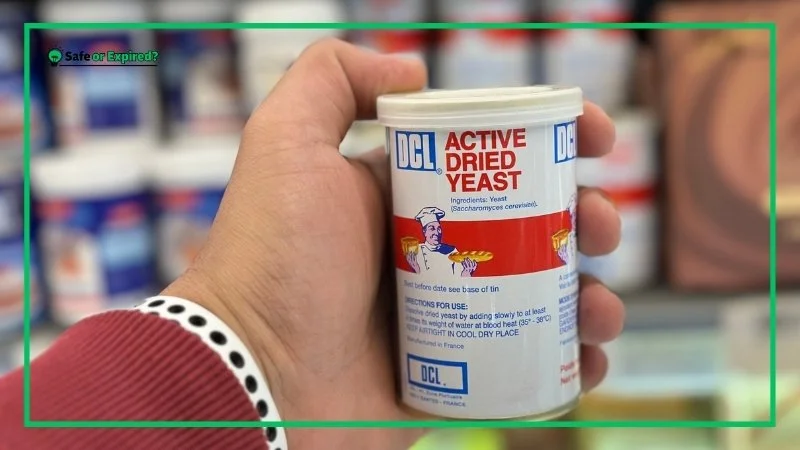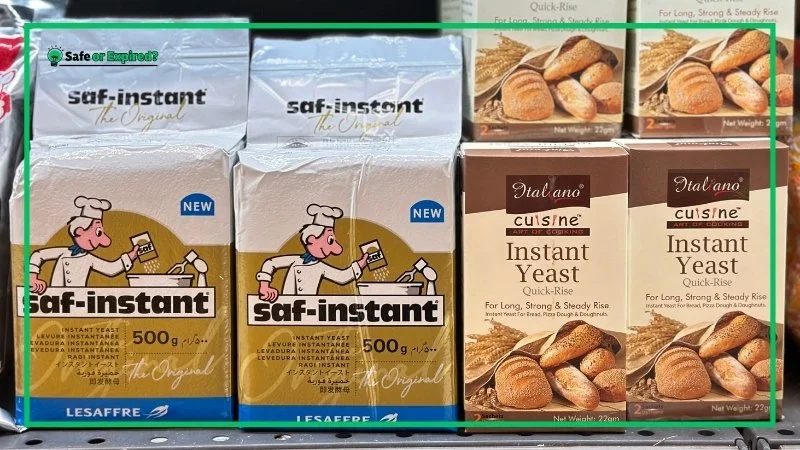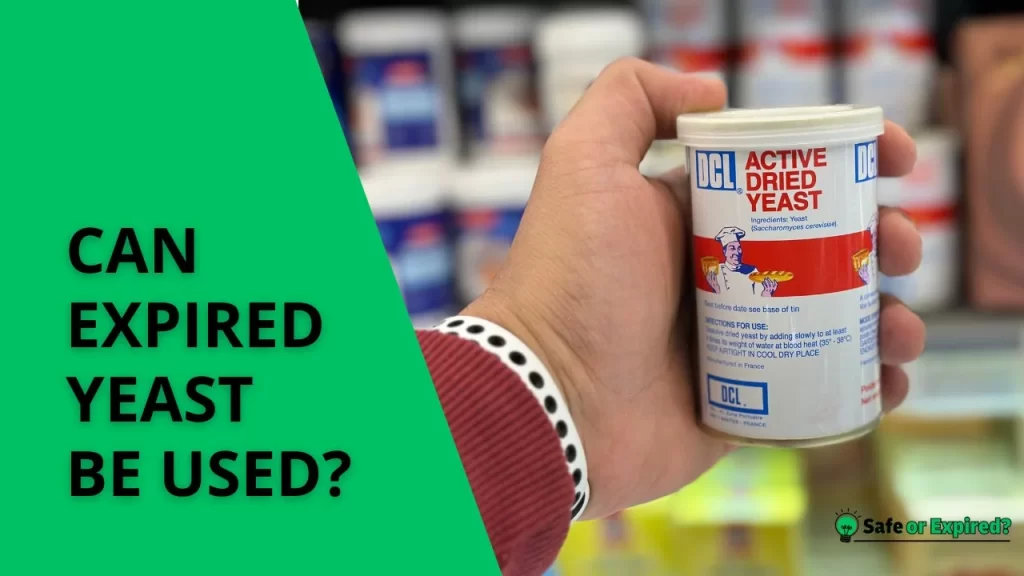“Can expired yeast be used?” You might ask yourself this question as you discover a packet of yeast hidden in the back of your cupboard, its best-before date long gone. The answer is yes, expired yeast can still be used, but you should know lots of other things, as its effectiveness may diminish over time.
Fear not, for this article is here to guide you through the myths and truths surrounding expired yeast. Stick to the end.
Can Expired Yeast Be Used? Is It Poisonous? Debunking Myths
Yes, expired yeast can still be used in baking. While it may lose some power over time, it doesn’t become instantly unusable after the expiration date. This date is more of a guideline than a strict rule for the people. You can see it on the package/can.

People often ask, “Is expired yeast poisonous?” No, using expired yeast in your baking does not introduce any toxic risks. Yeast, even past its prime, remains safe. The worst that could happen? Your dough might not rise as expected, but it won’t harm your health. So, there’s no need to toss that packet just yet!
What To Do with Expired Yeast? Practical Tips
Expired yeast can be used for many things, but people usually bake with it. You can also use it for gardening. It is rich in nutrients and can keep pests away. Moreover, expired yeast is also a great way to educate people about fermentation.
Can Expired Yeast Be Used in Baking?
Yes, expired yeast can find its way into your baking projects. Start by proofing it: mix the yeast with a little sugar and warm water. If it bubbles and froths, congratulations, it’s still ready to help your bread rise. This simple test saves yeast from being wasted and ensures your baking success.
You may be wondering, Can Expired Yeast Be Used for Bread?” Absolutely, expired yeast can still contribute to your bread-making process. The key is patience. Expired yeast may take longer to rise, so allow extra time for fermentation. Adjusting your expectations and baking schedule can turn a packet of expired yeast into a loaf of delicious, homemade bread.
Also, read the “Instructions for Use” that the companies print on the package or bottle. This will help you avoid any frustration or problems in the future.

For Gardening
Expired yeast is rich in nutrients that can benefit your garden. The yeast contains phosphorus, potassium, and nitrogen, essential nutrients for plant growth. You can mix expired yeast with water to create a liquid fertilizer or incorporate it directly into the soil around plants. This can help improve soil health and support plant growth.
Moreover, yeast produces carbon dioxide when it ferments, which can attract and trap certain garden pests. Mixing expired yeast with sugar and water in a container can create a simple, eco-friendly trap for insects like mosquitoes and fruit flies, reducing their populations around your outdoor living spaces.
Educational Science Experiments
Expired yeast can be a fantastic tool for educational purposes. It can be used in simple science experiments to demonstrate fermentation, cellular respiration, or the production of carbon dioxide.
What to Do with Expired Instant Yeast?
Expired instant yeast isn’t destined for the trash. Even if it’s past its prime, give it a proof test similar to active dry yeast. If it shows signs of life, use it in recipes that are forgiving and don’t require a massive rise. Think flatbreads, crackers, or even as a nutritional supplement in shakes.

How to Revive Expired Instant Yeast for Your Recipes?
To revive expired instant yeast, mix it with equal parts of warm water and sugar. Wait for 10 minutes; if the mixture bubbles, the yeast is still active and can be used in your recipes. This simple test helps ensure your baking success, even with yeast past its prime.
Testing the Yeast’s Viability
Before you start, it’s essential to check if the expired instant yeast is still active. You can do this via different methods, and all of them work. Here’s the simplest one: Dissolve a teaspoon (a few grams) of sugar in half a cup of warm water (around 110°F), then stir in your yeast. Wait for about 10 minutes. If the mixture bubbles and froths, your yeast is alive and ready for action!
Waking Up Your Yeast
If your yeast shows signs of life, welcome it back to the world of baking. To ensure it’s up to the task, prepare a “pre-ferment.” Mix the active yeast with equal parts flour and water and let it sit in a warm spot. This step reinvigorates the yeast, boosting its leavening power.
Adjusting Your Recipe
Revived yeast may be a bit slower, so adjust your expectations. Allow for longer rising times, and keep your dough in a warm, draft-free area. This extra time can enhance flavor development, leading to a more complex and tasty result.
What Does Expired Yeast Look Like? Painting a Picture
Expired yeast may appear clumpy and lose its uniform granular texture, shifting color toward a darker shade. While these visual cues can indicate age, the definitive test for viability involves checking if it activates in warm water and sugar, revealing if it’s still useful for baking.
How To Test Expired Yeast? (Step by Step)
To test expired yeast, dissolve one teaspoon of sugar in 1/2 cup of warm or lukewarm water (about 110°F), then add the yeast. Wait 10 minutes; if the mixture foams and bubbles, the yeast is still active and can leaven the dough. This simple test assesses whether expired yeast retains its baking effectiveness.
Gather Your Ingredients
You will need:
| Ingredient | Ideally, between 105°F and 115°F, as too hot can kill the yeast and too cold won’t activate it. |
| 1 teaspoon of sugar | To feed the yeast and stimulate activity |
| 1/2 cup of warm water | How much do you have? |
| The expired yeast you wish to test | How much do you have. |
Dissolve the Sugar
Pour the warm water into a small bowl. Add sugar and stir until completely dissolved. The sugar is important here, as it acts as “food” for the yeast, encouraging it to ferment and produce gas.
Add the Yeast
Sprinkle the yeast over the surface of the sugary water. There’s no need to stir it in; just let it sit on top. This allows the yeast to gradually hydrate and activate at its own pace.
Wait and Observe
Let the mixture sit in a warm place for about 10 minutes. During this time, active yeast will start to eat the sugar, producing carbon dioxide gas as a byproduct. This process is what causes the dough to rise.
Check the Results
After 10 minutes, check for signs of activity. Active yeast will create a creamy, frothy layer on the surface of the water, sometimes with bubbles. This indicates that the yeast is alive and capable of leavening dough. If the water remains flat and clear, with the yeast simply sinking to the bottom, it indicates that the yeast is no longer viable.
Lastly, store the remaining yeast in a dry place. If you don’t, a study by FEMS has shown that the yeats’s quality will keep on degrading as time progresses.

Troubleshooting
- No Activity? If there’s no sign of life after 10 minutes, it’s safe to assume the yeast won’t contribute to the rising of your dough. It’s best to replace it with a new packet.
- Partial Activity? Sometimes, you might observe minimal activity. This could mean the yeast is weak but not entirely dead. You can try using more of this yeast than your recipe calls for, but results can be unpredictable.
This curiosity about the shelf life of our baking ingredients extends beyond yeast. If you’re pondering whether that cake mix that’s been sitting on your shelf for a bit too long is still good to use, you’re in luck. For a comprehensive guide on what to expect from your cake mix and how to test its viability, check out “Can I Use an Expired Cake Mix? (Yes or No?) Find Out Now!”.
FAQs
Can Expired Yeast Be Used as Fertilizer?
Yes, expired yeast can be repurposed as a fertilizer for your garden. Yeast is rich in nitrogen, phosphorus, and other nutrients beneficial to plant growth. Mixing expired yeast with water and applying it to the soil can provide plants with a boost of essential nutrients. However, use this mixture sparingly to avoid over-fertilization.
Can Expired Yeast Be Used for Bread?
Expired yeast can still be used for bread, though its effectiveness might be reduced. To determine if it can still leaven dough, perform a viability test by dissolving the yeast in warm or lukewarm water with a bit of sugar. If the mixture bubbles and froths, the yeast is active and can be used in your bread recipe. Expect that the rising time may be longer, so patience is key.
Can You Use Active Dry Yeast That Is Expired?
Yes, active dry yeast that has expired can often still be used as long as it passes an activity test. This test helps to ensure that the yeast can still produce the gas necessary for leavening bread and other baked goods.
If the yeast shows activity, it can be incorporated into recipes with the understanding that the rising process may require more time.
Conclusion
In summary, yes, you can use expired yeast. Remember these critical points before you decide to do it:
- Testing is crucial: The viability of expired yeast can be easily assessed with a sugar and warm water test.
- Still beneficial: Active expired yeast can be used in recipes, requiring just a bit of patience for longer rising times.
- Beyond baking: Inactive yeast finds new life as a nutrient-rich addition to compost or garden soil, supporting plant growth.
This exploration confirms that expired yeast, far from being waste, holds potential for both culinary and gardening ventures.

